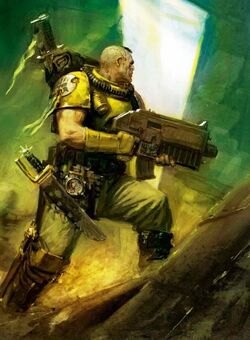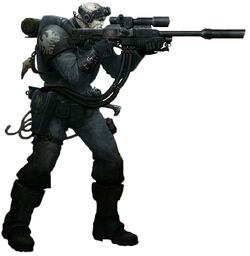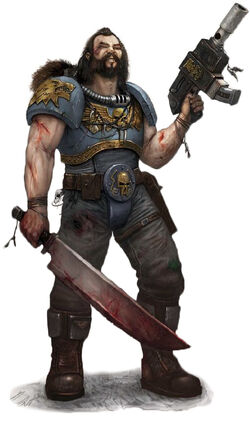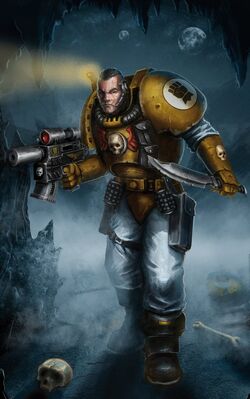"Forget all your preconceptions of war, of battle-lines clashing in the churned ground. Your mission is to attack before the foe even realises that the war has begun, to strike hard at those vital weaknesses that all armies possess, but that no commander will admit to. Under my tutelage you will learn how to seek out such fragilities and smite them with every weapon at your disposal. Master these duties and I will have nothing more to teach, and you will truly be a Space Marine."
- — Sergeant Torias Telion, Ultramarines 10th Company

A Scout Marine of the Imperial Fists Chapter

A Scout Marine of the Raven Guard Chapter armed with a modified Sniper Rifle

A Wolf Scout of the feral Space Wolves Chapter armed with an Astartes Combat Knife and Bolt Pistol
Scout Marines are the newest recruits in a Space Marine Chapter. Their duties are to infiltrate the enemy positions or to fight as lightly armed skirmishers ahead of the rest of the Chapter. Operating behind enemy lines, Space Marine Scouts set ambushes for their foes, spy out the enemy's movements, and gather what information they can about their opponent's plans. Sometimes Scouts will covertly attack an enemy camp, capturing a commander for interrogation or alternatively sabotaging equipment and supplies. Striking fast and hard, the Scouts usually accomplish their mission and leave before the enemy has the chance to respond. The 10th Company of a Codex Astartes-compliant Space Marine Chapter consists entirely of Scout Squads. Each Squad consists of a Scout Sergeant and up to nine Space Marine Scouts. There is no theoretical limit of how many Scout Squads there may be in the Company. However in practice there are rarely more than ten. The Squad number in white is shown on the right shoulder plate. Scouts do not show any Company badge, colour or number. The 10th Company does not have a battle standard or a Company Banner.
Scouts are essentially Space Marines who wear a lighter version of the standard Space Marine Power Armour similar but not identical to Imperial Guard Carapace Armour. The armour is not as strong a defence as the standard Power Armour but it is far less restrictive to movement and almost completely silent in operation. This makes it an ideal uniform for troops whose primary goal on the battlefield is to avoid detection. Scouts are employed in all kinds of reconnaissance, infiltration and other subterfuge. They are rightly valued for their ability to strike deep behind enemy lines without being seen and for the resultant confusion and terror this can cause.
Scout Marines are physically the same as other Space Marines but in many Chapters the 10th Company has a vital role as a training battalion and new recruits are inducted into the Scout Company before graduating to the Battle and Reserve Companies of the Chapter. In other Chapters the individual Companies have a responsibility for this training and the 10th Company includes many Marines with decades of experience.
More lightly armed and armoured than their more experienced Battle-Brothers, Space Marine Scouts chiefly fight as skirmishers, relying on stealth rather than brute force to accomplish missions. Scouts operate independently from the main Space Marine force, their duties including infiltrating enemy positions and clearing the way for the Chapter's advance. Operating deep within hostile territory, Scouts reconnoitre the enemy's movements, set ambushes for the unwary, sabotage supply lines and destroy communications centres in daring commando raids. Striking in silence, the Scouts' goal is to accomplish their mission and vanish before the enemy has the chance to retaliate.
When first inducted into a Space Marine Chapter, a recruit joins the ranks of the 10th Company as a Scout. He is placed under the tutelage of a sergeant who will lead him on the field of battle and instruct him in what it truly means to wage war as one of the Adeptus Astartes. Only once he has proven himself worthy of his Chapter by excelling in the ranks of the 10th Company will a Scout be deemed ready to join the main ranks of Battle-Brothers.
A new recruit has much to learn and must endure many long months of gruelling training regimes before he takes to the field of battle. Not only must he master the many biologically-engineered enhancements that are at work within his body, he must also learn the litanies of battle that fortify him and become skilled in wielding his wargear. Not all recruits survive their training, for no quarter can be asked or given when forging humanity's finest warriors, but those that emerge are well prepared for their first taste of battle as a Space Marine Scout.
Throughout his service as a Scout, the recruit is instructed by his sergeant, his actions guided, watched over and judged as he strikes the foe with Bolter and blade. The Scout will grow proficient with many other firearms, learning how to snipe the foe with longrange rifles and how to demolish enemy battle tanks with heavy weaponry. Whilst acting as part of an infiltration force, a Scout will become skilled at every aspect of war. He will learn that to be a Space Marine is to be death incarnate, no matter the terrain, the nature of the foe, or the weapons arrayed against him.
A Scout Squad is armed with a variety of different weapons. Bolters, Sniper Rifles, and Combat Shotguns are all commonly employed but the most favoured armament is a Bolt Pistol and Combat Knife combination. Scout Sergeants invariably carry a Chainsword, which is almost as much a badge of their rank as a weapon.
Scout Squads also have access to a number of different heavy weapons and one of the Scouts within the Squad may be armed with a Heavy Bolter, Autocannon or Missile Launcher. These are normally only used if the mission requires it. In most circumstances and missions the Scouts prefer to sacrifice firepower for stealth and speed. The whole Squad will also usually carry grenades of which the most common types are Frag Grenades (wide area, fragmentation blast) or Krak Grenades (tightly focused, armour-piercing blast). Other grenade types are occasionally used on special missions but are generally restricted to officers and squad leaders.
Scout Squads are also trained to fight as Bike Squadrons. This provides a highly mobile support for Scout Marines operating behind enemy lines.
Rites and Initiations

A Neophyte Scout Marine of the Imperial Fists Space Marine Chapter undergoing his final trials
Every Chapter of Space Marines must recruit new warriors into its ranks in order to survive. The process varies from Chapter to Chapter, many recruiting from their own homeworlds. These are often feral worlds, breeding tough, harsh new recruits. Whatever the tradition of a particular Chapter, warriors must always be chosen when they are still young, before their bodies become too mature to accept the many bio-implants. During those years, the warrior is known as a Neophyte, or Space Marine Scout - he is neither fully a Space Marine nor entirely a normal human. A Space Marine Scout has much to learn; not only must he become accustomed to the many biologically engineered enhancements which are at work on his body, but he must learn the litany of battle that will fortify and strengthen him. He will undergo several phases of initiation into the Chapter's own secret cults, and he will get his first chance to fight in battle. Space Marine Scouts are neither as tough nor as experienced as full Space Marines. Scouts can fight alongside other Space Marines in the main battle-lines, and often do so, during moments of desperation. Once chosen from the ranks of aspirants, a human warrior must undergo the ritual trials unique to his Chapter. Once accepted, the genetic implantation and induction of the Space Marine organs begins. The warrior has taken his first steps to becoming a full fledged Space Marine. The Scout is then placed under tutelage of a sergeant who will oversee his induction and training and also lead the Scouts in battle. Not yet ready to join a company, the young Scouts live alongside their brothers in the 10th Company halls where they will sleep and train, learning the history of their Chapter. Only after a Scout has proven himself in combat will his sergeant judge him worthy of the title of Space Marine, and declare him ready to join one of the companies.
The 10th Company
In the majority of Space Marine Chapters it is the responsibility of the 10th Company to train recruits, called Neophytes. As such, the Officers and Sergeants of the 10th Company are often amongst the most experienced members of the Chapter, usually having passed through the ranks of 1st Company and forgone promotion to a higher office. Though all of the Chapter's Scout Squads come from the 10th Company, it is very rarely fielded as a tactical unit. Instead its squads are detached to other Reserve or Battle Companies for deployment in the field. The Codex Astartes places no limit on the number of Scout squads that may comprise the 10th Company, although in practice few Chapters will ever have more than 10 squads at any one time. Most will have significantly fewer, depending on the suitablity of aspirants and the Chapter's casualty levels.
Chapters without a Scout Company
Some Chapters, the Black Templars being the most well-known, do not use a specialised company to train their recruits, rather the recruit, or Neophyte is "apprenticed" to a fully-fledged Battle Brother, or Initiate. Another notable exception to the practice is the Space Wolves, who place their successful Neophytes together into units called Blood Claws. Space Wolves do use Scout Marines, but they are experienced, veteran warriors who prefer solitude to service in a Pack and are known as Wolf Scouts, rather than young, inexperienced recruits.
Tactics and Training
A Space Marine must be fully versed in every conceivable aspect of warfare, even those he will not ultimately practice as a warrior. Thus, Scouts learn the art of subterfuge, approaching the foe unseen and striking before his presence is detected. Such tactics are rarely practiced by the Reserve and Battle Companies, as the Codex Astartes dictates a very direct form of warfare. Scouts usually perform reconnaissance missions in advance of the main force of Space Marines, gathering information, hunting down and terrorising enemy formations and relaying intelligence back to their leaders.
Specialist Equipment
Space Marine Scouts are issued all manner of specialised equipment. In many cases these items are crafted by the Chapter's Techmarines for specific roles or missions, and enable the Scout to carry out his mission with increased efficiency. Each Scout wears a tight-beam squad commlink, which is used to transmit encrypted data to the other members of the Scout Squad without the risk of enemy interception. The squad's leader has a long-range link that he uses to communicate with other units. A Scout's armour is constructed of heavy ceramite carapace plates, which are far lighter and quieter than power armor. While Scout Armour doesn't offer the same protection as true Power Armour, it is still easily capable of blocking or deflecting bullets, las-bolts, and shrapnel.
- "Stalker Pattern" Bolt Pistol - The Bolt Pistols used by Space Wolves Wolf Scouts are a modified version of the common Godwyn pattern in use by Astartes across the Imperium. Fitted with a suppressor unit to dampen its sound and muzzle flash, and an optical sight to augment the user’s aim, the Stalker pattern Bolt Pistol is intended for the sort of covert operations performed by Scouts.
- "Raven Pattern" Shotgun - Raven Guard scouts are among the best recon the Astartes has to offer, forging ahead of the Chapter, identifying targets for quick strikes and disrupting enemy logistics. For this reason, Raven Guard serving in the Jericho Reach Deathwatch are commonly deployed to strike missions in the Canis Salient, using their stealth to operate behind enemy lines and strike high value Tau targets. During a recent strike mission, shotgun fire gave away a scout’s position and compromised the entire mission. In response, Deathwatch Forge Master Harl Greyweaver used an ancient technique incorporating flash and sound suppressors into the scout’s weapon muzzle (a long black cylinder attached to the weapon’s barrel) making it completely silent when fired, without reducing damage or the ability to make use of variant forms of ammo. This modification was met with such great success that Greyweaver is willing to provide his time and skill to any Raven Guard who has proven himself worthy of the upgrade.
Scout Camouflage
Space Marines rarely use any form of camouflage, for their entire combat doctrine states that they are best deployed as shock troops, their very presence filling the enemy with terror. There are instances when a Chapter may utilise patterns approved by the Codex Astartes, and in most cases this is in relation to the role of Scouts. As ever, Scouts must be well versed in every aspect of war, and so an understanding of concealment and the use of camouflage is essential. These camouflage schemes may be applied to the armoured sections and fatigues of the Scout kit as well as on capes worn over the armour if the mission demands it. Furthermore, the Scouts are experts at covert warfare and will take account of the local environmental conditions when preparing for a mission.
Wargear
As a Space Marine whose training is not yet complete, a Scout Marines does not have access to much of the more formidable weaponry that their more experienced Battle-Brothers can utilise. They do not yet wear a suit of true Power Armour, and instead are outfitted with Astartes-sized Carapace Armour similar to what is worn by the higher-ranking members of the Imperial Guard. Modified to deal with the particular demands of life as a Scout Marines, this Carapace Armour is usually referred to as Scout Armour to differentiate it from the Carapace Armour worn by mortal Guardsmen. All Scouts are equipped with Bolt Pistols as their sidearm; their primary weapons includeBolters, Shotguns, Sniper Rifles, or powered Combat Knives to accompany their pistols. Designated Heavy Weapons Troopers can carry Missile Launchers or Heavy Bolters; unlike Tactical Marines, however, Scouts with Heavy Bolters have access to Hellfire Bolts, which are ideal for killing Tyranid bio-monstrosities or other large creatures. Scout Sergeants usually carry Bolt Pistols and Chainswords, but they can carry larger firearms (such as Bolters or Sniper Rifles) like their far less experienced squadmates. However, Sergeants are also given access to wargear such as Power Weapons, Plasma Pistols, and even Power Fists in certain rare instances. There are generally three types of Scout Squads in a Chapter's Scout Company:
- Assault Scout Squad: The Assault Scout Squad is composed of four Scout Marines armed with Combat Knives and Bolt Pistols, lead by a Sergeant armed with a Chainsword and Bolt Pistol.
- Tactical Scout Squad:The Tactical Scout Squad is composed of four Scout Marines armed with Bolters, a single Scout armed with a Heavy Bolter and a Sergeant armed with Bolt Pistol and Combat Knife.
- Sniping Scout Squad: The Sniping Scout Squad is composed of four Scout Marines armed with Sniper Rifles, a single Scout armed with a Heavy Bolter and a Sergeant armed with a Chainsword.
Sources
- Codex; Space Marines (6th Edition), pp. 85, 167
- Codex: Space Marines (5th Edition), pp. 16, 66-67, 75, 100, 102, 134
- Codex: Space Marines (3rd Edition), pg. 11
- Codex: Space Wolves (5th Edition), pp. 27, 88
- Codex: Space Wolves (3rd Edition), pg. 9, 32
- Codex: Space Wolves (2nd Edition), pp. 14, 46
- Codex: Ultramarines (2nd Edition)
- Deathwatch: First Founding (RPG), pp. 59, 98
- White Dwarf 305 (UK), "Behind Enemy Lines" by Matt Ward and "Silent Menace" by Andy Hoare
- White Dwarf 301 (UK), "Space Marine Heroes" by Graham McNeill
